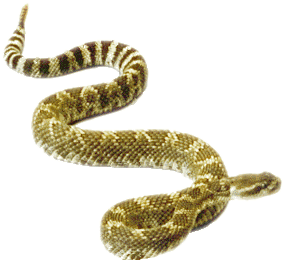Outdoors
Backpacking
Boating Safety
Camping List
Foil Dinners
Making a 1st Aid Kit
Snake Bites
Stove Cooking
Ticks
BPMeetup
Verse of the Day:
Active visitors: 34
Link of the Month:
Royal Rangers
Poisonous Snakebites
A poisonous snakebite is a potentially serious incident. It can lead to severe pain or other problems, and in the rare instance even death. However in North America it is not nearly as dangerous as most believe. Snakes seldom bite humans and even when they do so, their bites are seldom fatal. There is no need to allow fear of snakes to ruin your enjoyment of the outdoors. Identify poisonous snakes.
Snakes will usually avoid you if you give them a chance. Try to be sure they know you are coming. Don`t reach into places they might hide.  Be careful turning over rock and boards in snake country. Leave snakes alone; there is no simple rule to identify which are poisonous. The same advice applies to dead snakes and detached heads - reflex bites are as dangerous as bites from live snakes.
Be careful turning over rock and boards in snake country. Leave snakes alone; there is no simple rule to identify which are poisonous. The same advice applies to dead snakes and detached heads - reflex bites are as dangerous as bites from live snakes.
At least half of all bites are caused by foolish behavior: handling or taunting venomous snakes, or failing to move away from a venomous snake once it has been sighted.
If someone is bitten:
Snake Bite Symptoms
- Fang marks in the skin and swelling at the site of the bite
- Bloody wound discharge
- Severe localized pain
- Diarrhea
- Burning
- Convulsions
- Fainting
- Dizziness
- Weakness
- Blurred vision
- Excessive sweating
- Fever
- Increased thirst
- Loss of muscle coordination
- Nausea and vomiting
- Numbness and tingling
- Rapid pulse
The following treatment protocol is provided by Jeff Isaac and Peter Goth in The Outward Bound Wilderness First Aid Handbook, Lyons and Burford, 1991.
"Transport the patient as quickly as possible to antivenin (antidote). Although local discomfort may be severe, systemic signs and symptoms may be delayed for two to six hours following the bite. Walking your patient out is reasonably safe unless severe signs and symptoms occur. It is also significantly faster than trying a carry. Splint the affected part if possible.
Expect swelling. Remove constricting items such as rings, bracelets, and clothing from the bitten extremity.
Do not delay. Immediately following the bite of a snake thoughtto be poisonous, evacuation should be started. It can always be slowed down or canceled if it becomes obvious that envenomation did not occur, or the snake is not poisonous.
Most medical experts agree that traditional field treatments such as tourniquets, pressure dressing, ice packs, and "cut and suck" snakebite kits are generally ineffective and are possibly dangerous. Poisonous snakebite is one of those conditions that you cannot treat in the field. Don`t waste valuable time trying."
If it is going to be more than one hour to transport, you should consider rinsing and disinfecting the wound.